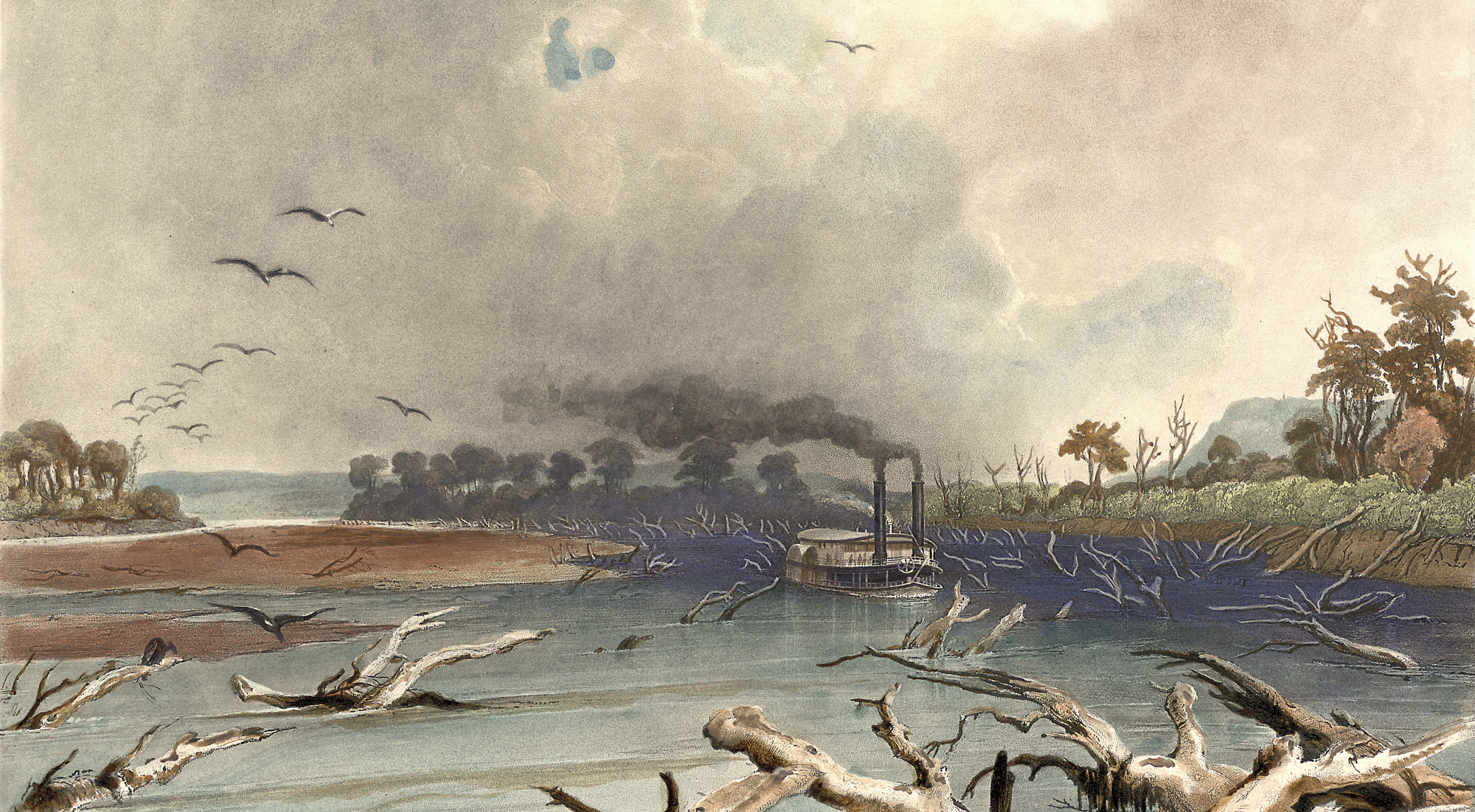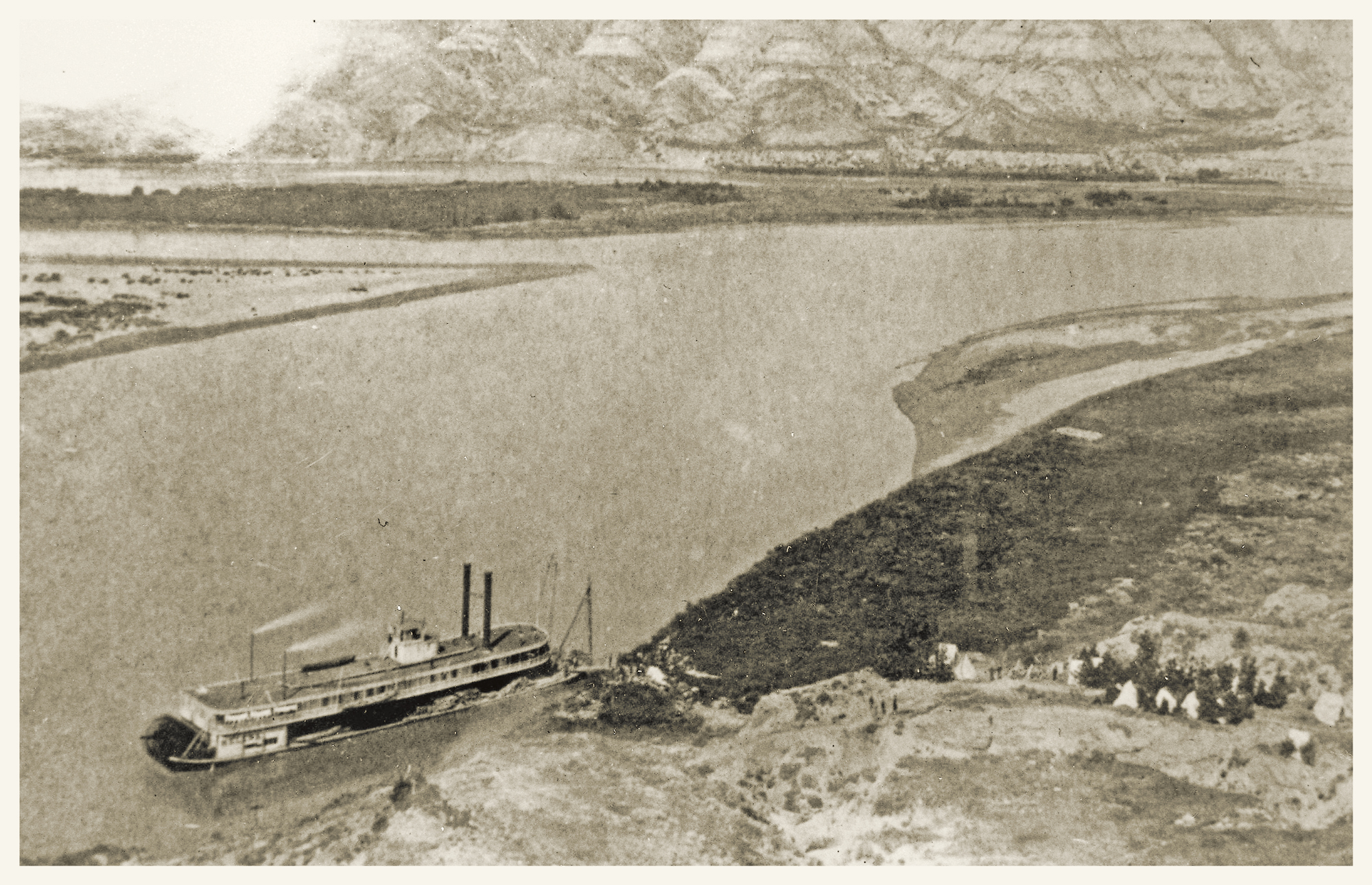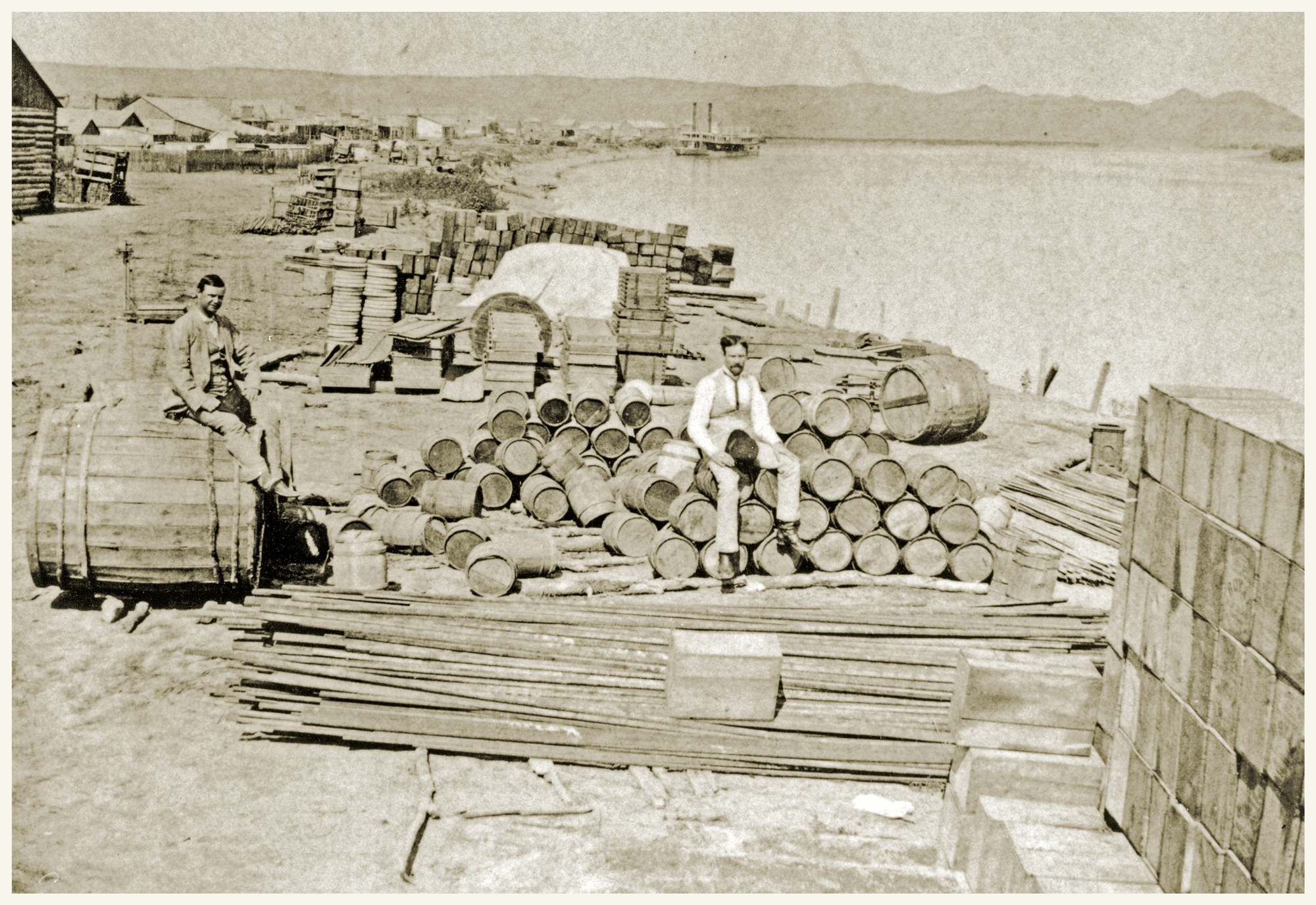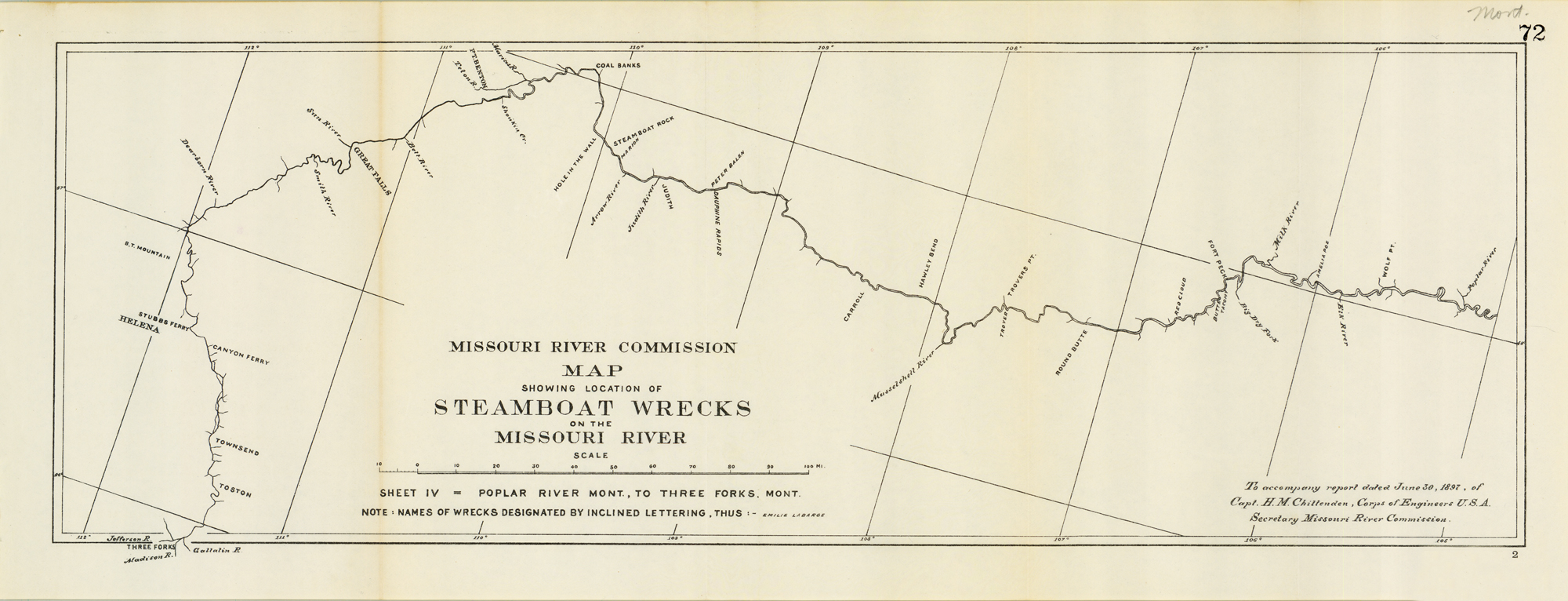
24 Jul Images of the West: “Steamboat A’Comin”
Steam navigation on the Missouri is one of the most hazardous things a man can undertake.
— Father Pierre Jean Desmet, 1838
THE ERA OF THE STEAMBOAT IN MONTANA was a dramatic opening act for Westward Expansion. Launched by a determined breed of rivermen who faced the harrowing trials of the Missouri River on hulking vessels that plied their way 2,300 miles from St. Louis to Fort Benton, Mont., it is a chapter in U.S. history marked by a national spirit of adventure. Mile after winding mile up the tortuous, shifting and meandering Missouri — through a country subjected to tornadoes, violent thunderstorms, fierce gales, irritating clouds of mosquitoes, not to mention unpredictable and sometimes hostile Indians — the smoke spewing steamers ran the gauntlet for the sake of prosperity and progress.
The Missouri, as documented by early writers, was a wild sinuous giant that worked incessantly to dissipate its unlimited supply of energy. The river was as rough, brawling and raucous as an old trapper’s recipe for Indian whiskey that caught my eye in the colorful historic museum at Fort Benton several decades ago:
To muddy Missouri water add:
One quart of alcohol
One pound of rank, black chewing tobacco
One handful of red peppers
One bottle of Jamaica ginger, and
One quart of black molasses
Mix well and boil until strength is drawn from the tobacco and peppers.
Waughhhh!
While exploring historical archives in search of information on the evolutionary development of the Missouri River, I found a maze of websites, newspaper clippings, books, magazine articles, bureaucratic memos, federal information bulletins, and other items that tell the story of the dramatic history of steamboat trade in Montana. That the Missouri was a moody, capricious river was well appreciated by early writers. Newspaper humorist George Fist described it as “a river that plays hide-and-seek with you today, and follows you around like a pet dog with a dynamite cracker tied to its tail.”
Meriwether Lewis was the first to pen his concern about the Missouri. “The difficulties which oppose themselves to the navigation of this immense river,” he wrote from his 1805 winter camp at Fort Mandan, “arise from the rapidity of its current, its falling banks, sandbars, and timber which remains wholly or partially concealed in its bed … to these we may add a fifth and not very much less inconsiderable difficulty, the turbid quality of the water, which renders it impossible to discover any obstruction even to the depth of a single inch.” Lewis would have been astonished to know that despite the amalgam of river hazards, approximately 700 different types of steamboats plied the Missouri between 1819 and the disappearance of paddlewheel traffic after 1900.
Before the steamboat era, few Missouri River travelers — if any — had the luxury of riding all the way up the Big Muddy. They poled, paddled, pulled and sailed part of the way, but for many stretches of the river they waded — slipping and falling as they lurched along treacherous banks, towing their mackinaws or keelboats upstream. The wind constantly blew, many times from the wrong direction, or it didn’t blow at all, so sails were of little help in bucking an impetuous current. It was a life reserved only for the hardiest.
About 1811, the first smoke-belching contraption known as the steamboat joined the river flotilla of pirogues, mackinaws and keelboats and would eventually replace them. Drawing six feet of water, the first side-wheeler steamboats were underpowered and essentially limited to the deeper, lower river. It was not until the 1850s that a serviceable steamboat — the stern-wheeler — arrived on the Missouri. It possessed a stout hull and a protruding spoon-shaped bow. The shallow-drafted craft, with reduced superstructure to counter high winds, could carry 300 to 400 tons of freight and 200 to 300 passengers while drawing less than three feet of water. Another special feature was the rigging carried from wooden masts at the head of the boat which were used for “sparring.” When no feasible route through a shallow shoal crossing in the river was obtainable, the craft would be “sparred” or “walked” over the sand bar to deeper water after the cargo was shifted from bow to stern. For this maneuver, two huge poles, or spars, were lowered to the bottom of the river at a 45-degree angle. Cables then were attached to a slow-rotating steam-powered capstan, and the boat was “grasshoppered” ahead, one step at a time, up and over the obstruction, until it finally floated free.
To clear shallow and impassable rapids during a low-water year, part of the cargo from heavily laden steamers had to be unloaded on shore. Once lighter, the steamers then proceeded to Fort Benton, unloaded, and returned for the remainder of the cargo left at the rapids. In the parlance of the river, this was “double-tripping.” In 1869, a year of extremely low flows, 18 of the 24 steamers that made it through had to double-trip from Dauphine’s Rapids in order to reach Benton.
Montana: “Chicago of the Plains”
Originally a buffalow and fur trading post, Fort Benton was a gateway to the Western Frontier in its time. The discovery of gold in Montana at Grasshopper and Gold Creeks, Confederate, Alder and Last Chance Gulches in the early 1860s prompted construction of the Mullan Road from Fort Benton to Fort Walla Walla, Wash., and the ensuing extension of steamboat traffic to Fort Benton served as a catalyst in the development of the Montana Territory. During the first six years after the big strike at Alder Gulch in 1863, 143 steamboats docked at Fort Benton. This bustling, ramshackle boomtown, described as the “Chicago of the Plains” by the editors in the introductory chapter of Paul F. Sharp’s Whoop-Up Country, was destined to become a loadstone of regional history.
In the late 1860s, thousands of miners pushed into Montana and took millions from Montana mines. In 1863, approximately $8 million, mostly in minerals, floated down the Missouri in steamers bound for St. Louis and elsewhere. In 1867 and 1868, $24 million in precious minerals was taken out of Montana and 80 percent of this wealth went down the Missouri River. Five-sixths of Montana’s wealth reportedly left the region via the Missouri in the 1860s. Fort Benton reflected the nature of the Missouri River and the steamboat trade. Activity became frenetic during May and June when most of the steamers arrived. Turn-around time for steamboats was short because, after unloading cargoes, river captains headed downstream while water levels still permitted navigation.
Hazardous Profit
Missouri steamboat travel, even with relatively modernized boats, was notoriously marked with woes: Boats were buried by sandbars, ravaged by fire, pulverized by ice, skewered by snags, ripped to kindling by powerful winds, devoured by rapids, trapped on shoals by falling water levels, plagued by irksome delays of vexing winds and huge herds of buffalo crossing the river, and blown to bits by violent boiler explosions. Despite the existing hazards, and the dangers herein, it is not surprising that the life span of the average Missouri steamboat was in the range of three years.
Despite the eccentricity of the Missouri and its hazards, steamboats kept heading upstream. Of 46 vessels bound for Fort Benton in 1867, 15 didn’t complete the trip. The risks, however, were worth taking and the steamers that beat the odds usually made more money than the vessel was worth. Thus, with profits in sight that would pay for their steamers twice over, owners waged their vessels against the gauntlet of the river. The reported profits of some voyages in 1866 included: the Peter Balen, $65,000 — a small fortune at this time; the Deer Lodge, $45,000; the Cora, $50,000; the W. J. Lewis, $40,000; and the Octavia, $40,000. In 1867, the Peter Balen had gross freight receipts which totaled approximately $80,000. Freight rates were equally as favorable to the carrier, averaging approximately 11 cents per pound from St. Louis to Fort Benton. Passenger rates varied from $100 to $200, depending on the season, the boat and the volume of business. The upriver trip from St. Louis to Fort Benton was usually made in about 60 to 65 days. Steamers generally left St. Louis in late March or early April, in order to take advantage of early spring floods and generally arrived in Fort Benton in May, June or early July.
For a decade following 1866, the army was the biggest shipper on the Missouri, chartering boats, hiring captains and pilots, and transporting troops and military supplies to a string of forts on the upper river.
A Daring Breed
A river pilot had to be capable of split-second decisions: He had to be able to guess at a glance the speed of the current in a bend, deciding from surface swirls whether the river concealed rocks, sandbars or snags. Piloting a steamboat was a profession demanding an incredible knowledge of water dynamics as well as copious amounts of courage and moral stature. Captain-pilots, for the most part, learned the basics of their craft as lowly deck hands or cabin boys. All earned respect for their ability to cope with Indians, unreliable machinery and troublesome crews. Missouri River pilots considered themselves archetypes of their breed, commanding salaries as high as $1,500 a month and attracting their share of eccentrics.
“In order to be a pilot a man had to learn more than any man ought to be allowed to know, “ wrote Mark Twain about the requirements demanded of rivermen, adding: “He must learn it all over again in a different way every 24 hours.”
Two of the most accomplished captain-pilots of the steamboat era on the Missouri included Joseph La Barge and Grant Marsh. Both were helmsmen of incredible coolness, judgment, navigating skills and were highly admired by fellow rivermen and passengers. La Barge, the most acclaimed of rivermen during the era of steamboating, never lost or even damaged a boat during his 20 years of voyages in dangerous waters — an incredible feat.
Grant Marsh started his career on steamers as a cabin boy at age 12, spending a total of 32 years defying the Missouri’s reputation as a graveyard for steamboats. Known as “the grand old man of the rivers,” Marsh piloted the steamer Far West’s record-breaking journey to Bismarck and Fort Abraham Lincoln from the Bighorn River with the wounded from Custer’s Last Stand.
Insatiable Appetites
Steamboats had insatiable appetites for wood. Trees along riverbanks were handy sources of cheap energy and since steamboat owners valued speed, power and performance over efficiency (and safety), little, if any, concern was given to the ecological impact of the removal of cottonwood and ash groves and the wildlife utilizing them. The need for wood was always critical, especially in areas on the upper Missouri where trees were scarce. In those remote areas where there were no people selling wood, steamers had to put ashore where the boat’s crew could fell trees, gather driftwood and take as much wood as could be piled on deck. Green, wet wood was poor fuel and did not produce much steam. Barrels of lard were often used to make it burn. A typical steamer ate up 30 cords a day. The log of the steamer Henry M. Shreve mentions that on her 67-day journey from St. Louis to Fort Benton in 1969, 1,051 cords of wood (mostly cottonwood) were purchased for $6,048.70. Prices ranged from $2.50 to $15 per cord, and averaged $5.75 per cord. The Shreve stopped 71 times to take on wood. Steamer pilots typically could plan on spending about $100 per day for wood.
Simple mathematics illuminates the ecological dimension of timber “mining” in the streamside (riparian) zone. Approximately 400 steamboat arrivals were recorded at Fort Benton between 1860 and 1888. During 1867, the peak of steamer traffic, 39 stern-wheelers were on the river between the mouth of the Yellowstone and Fort Benton. If one assumes the average travel time between these two points was about 23 days, and 30 cords were utilized per day, 400 steamers smoked up about 276,000 cords without calculating downstream usage. Stretched end-to-end in a straight line, 276,000 cords would stretch 418 miles or fill a gargantuan woodbin with 35,328,000 cubic feet — enough wood to build 26,663 modern three-bedroom houses.
Steamboat pilots were dependent on the bravery and cunning of men who operated out of lonely wooded groves along the upper Missouri, woodcutters known to the steamer’s crew as “woodhawks.” It was a hazardous and often a suicidal occupation as Indians tried to deny boats fuel as a corollary to more serious harassment. Historian Raymond Welty estimated that between 1867 and 1869, nearly one-third of the woodcutters along the banks of the Missouri were killed.
If one takes the time to pursue the wealth of literature on steamboats, it soon becomes clear that this was an era of exploitation, greed and an expectancy that the wildlife resource was inexhaustible. In some of the eastern states, there was an awakening realization that the nation’s resources were finite. But this realization had not yet dawned on the Western Frontier.
On April 25, 1843, John James Audubon boarded the steamer Omega at St. Louis with the boisterous company of trappers, soldiers and sportsmen bound for Fort Union, N.D. Below Fort Pierre they passed four barges with 10,000 buffalo hides. At one bend in the river, hunters shot four buffalo and brought back one tongue and a few choice pieces of the hump meat. “Thus it is,” noted Audubon, “that thousands of buffalo are murdered in senseless play, and their enormous carcasses are suffered to be the prey of the wolf, the raven, and the buzzard.”
The steamboat journals are replete with tales of wanton wildlife slaughter by steamboat passengers. As reported by John Napton during his trip to Fort Benton on the Imperial in 1867, the sport of shooting buffalo from the deck of a steamer was an exciting event. Somewhere west of the Yellowstone River, the young prospector wrote: “We are now evidently in the buffalo country … Soon afterwards we saw another big band of buffalo — thousands of them — crossing the river, going south and the boat was headed for them and struck about the middle of the herd. Then the wheel was reversed, in order to hold the boat amongst them, and everybody shooting with pistol, shotgun or pistol … Three or four cows were hauled aboard, and this ended the slaughter.”
Undoubtedly, steamboat traffic played a supporting role in destruction of the great migrating buffalo herds. The early steamers transported scores of buffalo hunters to jumping off points, and later transported tons of hides and meat from slain buffalo. In 1878, buffalo robes were still an important commodity: 72,000 hides were shipped via steamer from Fort Benton that year.
Invisible Cargo: Disease and Death
Historic archives of the western movement show there was no more dangerous carrier of dreaded diseases such as smallpox and cholera than the steamboats that plied their way up the Missouri. Plains Indians had little or no resistance to the deadly smallpox virus transmitted through close respiratory contact, often with devastating results. Captain-pilot Joseph La Barge is reported to have said that the shores of the Missouri were a continuous graveyard. Crewmen and passengers dying from outbreaks of cholera and smallpox were buried at hundreds of places in unmarked graves.
In 1837, the steamer St. Peters left St. Louis en route to Ft. Union, N.D., and earned an infamous niche in the annals of western medicine by touching off an epidemic of smallpox that afflicted nearly every tribe from the Platte to the Rockies. The virulent virus was first unleashed among the Mandan Indians at Ft. Clark and in a few short weeks, hundreds of fatalities occurred. From the infected Mandans, the plague spread and inflicted additional outbreaks on nearby Arikaras, Pawnees and Minnatarees. As the St. Peters moved upstream, the smallpox virus was transferred to Indians at Fort Union. From here the disease spread to other tribal members and to outlying tribes such as the Crow and Blackfeet. By the end of the next year after the St. Peter’s departure from Ft. Union, an estimated 15,000 Northern Plains Indians had died from the disease.
The End of a Rough and Romantic Era
The steamboat era on the upper Missouri and Yellowstone played a significant role in the development of the West, but like many other commercial enterprises, it didn’t last long. It was an arrested moment when the West was young. On May 10, 1869, the Golden Spike at Promontory Point, Utah, forged the link between East and West with iron rails, and Montana lost some of its frontier isolation. With the arrival of the transcontinental railway, a new day dawned for the residents of the territory. Major economic emphasis was no longer on river and steamboats, but on rails and locomotives which eventually came to Montana in 1887 when James J. Hill’s Manitoba Railroad made a great leap westward and cut off the last competition-free water route from Bismarck to Fort Benton. The locomotive was one predator the steamboat could not elude or compete with economically. The bonanza days of river traffic faded gradually and in 1889, the F.Y. Bachelor unloaded the last shipment of commercial freight at Fort Benton.
And soon after, it ended. The steamboat colors were hauled down and with them disappeared the steamer’s mournful whistle, colorful captains, pilots, boisterous crews, flashing stern paddles, and welcome shouts of “Steamboat a’comin’!”
- Art by Karl Bodmer (1809-1893), entitled “Snags (Sunken Trees) on the Missouri.” A steamboat works its way through sunken trees on the river. Karl Bodmer’s illustrations to Prince Maximillian of Wied-Neuwied’s “Travels in the Interior of North America,” 1832-34. Maximilian commissioned Bodmer to create illustrations to accompany the text of his atlas documenting their travels. These illustrations include 81 plates of hand-colored aquatints.








No Comments